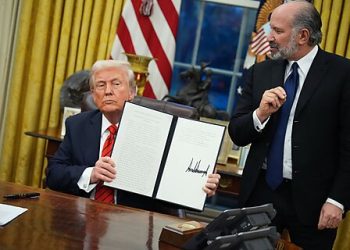Norbert Michel and Jerome Famularo
On October 14, Fed Chair Jerome Powell delivered a speech about the Fed’s balance sheet, and to start, he joked that this topic is comparable “to a trip to the dentist, but that comparison may be unfair—to dentists.” As people who frequently write about this topic, we empathize.
Hardly anyone cared about the Fed’s balance sheet prior to the 2008 financial crisis, but the Fed’s decision (in December 2008) to start purchasing long-term Treasuries and agency mortgage-backed securities (MBS) changed all that. By 2014, the Fed had engaged in three separate rounds of these purchase programs, known as quantitative easing (QE), and it held more than five times the securities it had prior to 2008. While the Fed eventually began a slow runoff of these securities after 2014, it engaged in massive securities purchases during the COVID-19 pandemic, bloating the balance sheet far above the previous peak.
Agency MBS, the securities issued by Fannie Mae and Freddie Mac, have always been one of the more controversial components of these purchases. Rather than provide liquidity on an economy-wide basis, these MBS purchases helped allocate credit directly to housing markets. Moreover, they helped prop up the market for Fannie’s and Freddie Mac’s debt while the companies were in federal conservatorship. During the COVID-19 pandemic, these purchases opened the Fed to even more criticism because they occurred after eight years of increasing housing prices and coincided with mortgage rates declining to their lowest levels in decades.
In his speech, Chair Powell acknowledged recent research that suggests the Fed’s MBS purchases between 2020 and 2022 were related to increasing home prices. Powell also noted, correctly, that the Fed’s MBS purchases were not the only factor driving house price appreciation during the pandemic. There were likely other causes, such as the increase in demand stemming from the rise in remote work.
Still, some research, including a paper from the Kansas City Fed, suggests that these MBS purchases affected both borrowing rates and housing prices. Given the size of the Fed’s purchases, this relationship is not too surprising.
As Figure 1 shows, during its initial QE programs, agency MBS purchases resulted in the Fed taking a 21 percent share of the MBS market in 2010 and nearly a 30 percent share by 2014. Their share of the market fell prior to 2020 but soon increased to almost 30 percent. During these purchase programs, the Fed was the second largest investor in the MBS market—combined, the Fed and the banking sector held more than a 50 percent share of the MBS market.
Given such a large volume, it would be strange if the Fed’s MBS purchases had no effect on home prices or interest rates. Additionally, compared to purchasing Treasury securities, MBS purchases should have a more direct effect on mortgage rates and house prices because they artificially increase demand for mortgages.
This paper by the Kansas City Fed estimates that the Fed’s MBS purchases between 2020 and 2021 led to a 0.4 percent decrease in the difference between mortgage rates and Treasury yields, a difference known as the mortgage spread. During much of this period, mortgage rates were decreasing, and long-term Treasury yields were increasing. The paper reports that “banks and the Fed were each responsible for about a 40-bps reduction in the mortgage spread during 2020/21,” leading to “a cumulative increase in mortgage originations of about $3 trillion and net MBS issuance of about $1 trillion, with banks responsible for about half of this increase.”
When mortgage rates drop, more people can afford mortgages, which increases demand for houses. This surge in demand, all other things held constant, increases house prices until supply increases to meet the new demand. There is a range of estimates for the effect of mortgage rates on house prices, and recent estimates suggest that the effect has been increasing and was particularly strong during the pandemic.
What began as a temporary emergency response to a crisis has morphed into a primary feature of modern central banking. As a result, the Fed’s balance sheet has ballooned to historic proportions, from less than $1 trillion in 2007 to nearly $9 trillion at its peak in 2022, largely due to successive rounds of QE. Whether QE worked as intended is debatable, but it has undoubtedly expanded the Fed’s balance sheet and drawn the Fed into financial markets and fiscal policy beyond its traditional role.
In particular, the Fed’s MBS purchases have distorted the housing market, pushing prices higher and fueling calls for even more government intervention. To prevent direct credit allocation and to minimize the Fed’s footprint on financial markets, Congress should require the Fed to trade only short-term US Treasury securities. That process might be politically difficult, but it wouldn’t be as bad as going to the dentist.
















